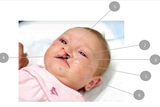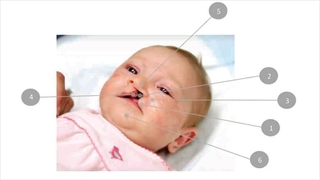Post
Cleft Care: From Birth Through Adolescence
June 14, 2020

Review a timeline of common cleft lip/palate procedures and typical age of treatment, from birth to adolescence.
1. Procedure: Lip Repair
- Common Age: 3-6 months
- Lip repair restores continuity of the lip muscle that guides mouth growth, and appearance of the lip and lower nose. At this age, repair is very safe from an anesthesia standpoint, and scars tend to heal very well.
2. Procedure: Palate Repair
- Common Age: 9-15 months
- The palate is reconstructed from mucosa and muscle tissue that has retracted to the sides of the mouth, and emphasizes palatal lengthening. Repair is important for proper development of speech, and stops nasal regurgitation of fluid.
3. Procedure: Alveolar Bone Graft
- Common Age: 6-10 years
- Patients who have a cleft of their alveolus (the bone from which teeth grow) have this repaired typically using bone from their hip at the time their adult teeth are erupting into position. Orthodontic care accompanies this process.
4. Procedure: Secondary Speech Surgery
- Common Age: 4-18 years
- After speech begins, some patients will require a secondary surgery to bolster and strengthen tissue around their throat to improve the quality of speech. This decision is made in conjunction with cleft speech-language pathologists.
5. Procedure: Tip Rhinoplasty Complete Septorhinoplasty
- Common Age: 5-15 years
- Common Age: 15-18 years
- A cleft nasal deformity involves slumping of the external nasal cartilage and a blockage of the internal nasal septum, both of which make breathing difficult and contribute to a stigmatizing appearance. Minor adjustments to the shape of the nose can be made earlier in the form of a tip rhinoplasty, but definitive nasal correction is done at skeletal maturity.
6. Procedure: Orthognathic (Jaw) Surgery
- Common Age: 15-18 years
- The midface of some patients, particularly those with cleft palate, may not grow sufficiently. This can cause the upper teeth to close behind the lower teeth and affect chewing and speaking, as well as cause obstructive sleep apnea. Orthognathic surgery repositions the upper and/or lower jaws to enable the teeth to fit together optimally and restore facial projection.

Featured in this article
Specialties & Programs
Review a timeline of common cleft lip/palate procedures and typical age of treatment, from birth to adolescence.
1. Procedure: Lip Repair
- Common Age: 3-6 months
- Lip repair restores continuity of the lip muscle that guides mouth growth, and appearance of the lip and lower nose. At this age, repair is very safe from an anesthesia standpoint, and scars tend to heal very well.
2. Procedure: Palate Repair
- Common Age: 9-15 months
- The palate is reconstructed from mucosa and muscle tissue that has retracted to the sides of the mouth, and emphasizes palatal lengthening. Repair is important for proper development of speech, and stops nasal regurgitation of fluid.
3. Procedure: Alveolar Bone Graft
- Common Age: 6-10 years
- Patients who have a cleft of their alveolus (the bone from which teeth grow) have this repaired typically using bone from their hip at the time their adult teeth are erupting into position. Orthodontic care accompanies this process.
4. Procedure: Secondary Speech Surgery
- Common Age: 4-18 years
- After speech begins, some patients will require a secondary surgery to bolster and strengthen tissue around their throat to improve the quality of speech. This decision is made in conjunction with cleft speech-language pathologists.
5. Procedure: Tip Rhinoplasty Complete Septorhinoplasty
- Common Age: 5-15 years
- Common Age: 15-18 years
- A cleft nasal deformity involves slumping of the external nasal cartilage and a blockage of the internal nasal septum, both of which make breathing difficult and contribute to a stigmatizing appearance. Minor adjustments to the shape of the nose can be made earlier in the form of a tip rhinoplasty, but definitive nasal correction is done at skeletal maturity.
6. Procedure: Orthognathic (Jaw) Surgery
- Common Age: 15-18 years
- The midface of some patients, particularly those with cleft palate, may not grow sufficiently. This can cause the upper teeth to close behind the lower teeth and affect chewing and speaking, as well as cause obstructive sleep apnea. Orthognathic surgery repositions the upper and/or lower jaws to enable the teeth to fit together optimally and restore facial projection.

Contact us
Cleft Lip and Palate Program